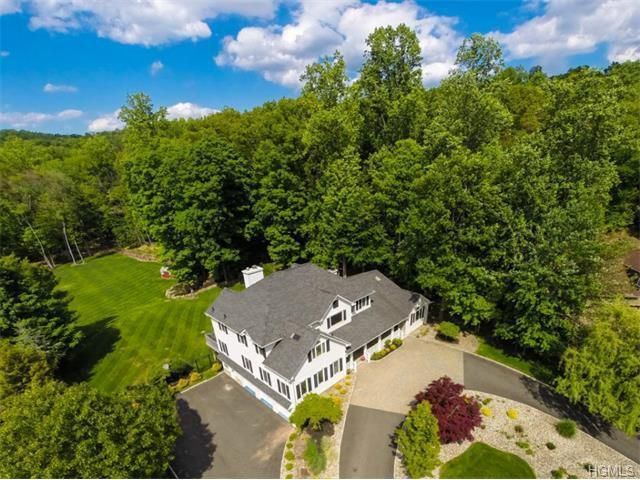Country United States County Rockland FIPS code 36-06860 Elevation 61 m Population 5,689 (2010) | State New York Time zone Eastern (EST) (UTC-5) GNIS feature ID 0944231 Zip code 10913 Area code Area code 845 | |
 | ||
Area 11.91 km² (11.65 km² Land / 26 ha Water) | ||
Blauvelt is a hamlet and census-designated place, formerly known as Greenbush and then Blauveltville, in the town of Orangetown, Rockland County, New York, United States. It is located north of Tappan, east of Nauraushaun and Pearl River, south of Central Nyack, and west of Orangeburg. As of the 2010 census, the CDP had a population of 5,689.
Contents
- Map of Blauvelt NY USA
- Geography
- Demographics
- History
- Historical markers
- Landmarks and places of interest
- Notable residents
- References
Map of Blauvelt, NY, USA
Geography
Blauvelt is located at 41°03′52″N 73°57′25″W (41.064396, -73.956881).
According to the United States Census Bureau, the CDP has a total area of 4.6 square miles (12 km2), of which 4.6 square miles (12 km2) is land and 0.1 square miles (0.26 km2), or 1.52%, is water.
Demographics
As of the census of 2000, there were 5,207 people, 1,564 households, and 1,313 families residing in the CDP. The population density was 1,144.4 per square mile (441.9/km2). There were 1,588 housing units at an average density of 349.0/sq mi (134.8/km2). The racial makeup of the CDP was 88.42% White, 1.56% African American, 0.02% Native American, 7.34% Asian, 1.44% from other races, and 1.23% from two or more races. Hispanic or Latino of any race were 5.93% of the population.
There were 1,564 households out of which 38.7% had children under the age of 18 living with them, 71.9% were married couples living together, 8.8% had a female householder with no husband present, and 16.0% were non-families. 13.6% of all households were made up of individuals and 8.2% had someone living alone who was 65 years of age or older. The average household size was 3.08 and the average family size was 3.40.
In the CDP, the population was spread out with 25.6% under the age of 18, 9.8% from 18 to 24, 25.9% from 25 to 44, 22.2% from 45 to 64, and 16.6% who were 65 years of age or older. The median age was 38 years. For every 100 females there were 90.4 males. For every 100 females age 18 and over, there were 88.7 males.
The median income for a household in the CDP was $103,071, and the median income for a family was $104,944. Males had a median income of $90,125 versus $80,096 for females. The per capita income for the CDP was $94,211. About 1.9% of families and 3.5% of the population were below the poverty line, including 2.1% of those under age 18 and 11.5% of those age 65 or over.
History
The name "Blauvelt", of Dutch origin, is that of a prominent family that settled in the area in the 17th century. The etymology of the name probably comes from the coat of arms adopted by the first Blauvelt, Pieter Blauwveld, a prominent trader in the Netherlands. Literally, it means "blue-field", or "blue pasture fields", likely a reference to the blue and yellow shields hung on Pieter's ships (a common 14th century Dutch method of identifying the owner). The first Blauvelt in America was a peasant farmer who worked on Kiliaen van Rensselaer's estate cultivating tobacco, in 1638.
In 1909, New York State purchased property in Blauvelt to create Camp Bluefields, a large rifle range used to train members of the New York National Guard prior to World War I. The property was later used by the YWCA, ROTC, Columbia University and the U.S. Army for various purposes before being abandoned following World War II. The land is today the site of Blauvelt State Park.
In 1972, Robert Salvia and Professor Dr. Paul Olson of the Lamont–Doherty Earth Observatory, a research unit of Columbia University located on a 157-acre (0.64 km2) campus in Palisades, New York, discovered several 200-million-year-old dinosaur tracks that were identified as being from the coelophysis. Some of these tracks were sent to the New York State Museum in Albany, New York for identification and preservation. The fossils date from the Triassic period and are claimed to be the only dinosaur tracks ever discovered in the state of New York.
The 914 Sound Studios was a musical recording studio in the 1970s. Several albums were recorded in Blauvelt, including the title track of Bruce Springsteen's album Born to Run in 1974.
Historical markers
The Jacob J. Blauvelt house and its four remaining acres of land had been in the Blauvelt family since the time it was built, in 1832, up until when it was acquired by the Historical Society of Rockland County in 1970. The Blauvelt family first arrived in America in 1638, and first arrived in Rockland County in 1683. Their genealogy today contains more than 26,000 names.
